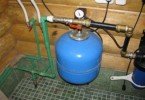Many owners of their own homes want to have a well in their yard. Even if the house already has a central water supply, and on the next street – a column. The well creates a unique atmosphere of true home ownership and lifestyle, which is so lacking now. And there’s no need to talk about the quality of drinking water from a well-placed well!
Content
- Search for water for a well
- Grandfather Methods
- More advanced ways
Search for water for a well
How to find water for a well is a topic for another discussion. The task of the seekers is to determine the location of the underground aquifer. Everything is clear here. But how do you know where the bed of this invisible underground river is?
There are a lot of methods for finding water. Some of them have been living among the people for hundreds of years. Sometimes they seem to us too exotic. Although, in fairness, it is worth recognizing that many of them work. Therefore, we will begin our acquaintance with the methods of water search precisely with the “grandfather” methods.
Grandfather Methods
For the purity of the experiment, let’s first get acquainted with the signs that for centuries have helped to search for water. We list the most popular of them:
- fog that spreads over the aquifer in the morning;
- swarms of midges over a particular site;
- the presence of some herbs (chick, sedge, coltsfoot) and trees (spruce, birch, alder);

Popular sign: if the willow grows on the site, it means there is water underground
- chicken eggs that misted up at night under a frying pan, and so on.
Immediately it is necessary to dot all the “i”. Yes, signs work – there is water in those places. And, most likely, there are a lot of it. But often this water is stagnant, low-lying, and it can be used only for technical needs.
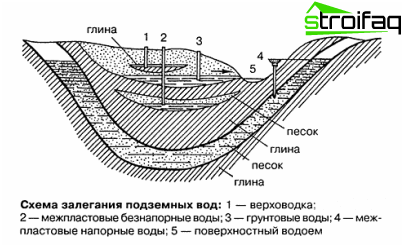
Groundwater pattern. Vekhovodovka (No. 1) is only suitable for wells with process water. Those who want to get excellent drinking water should be guided by levels No. 2 and No. 3
Separate conversation deserves dowsing.
Dowsing or dowsing is one of the ancient ways of finding water. It is believed that underground waters, like the human body, have magnetic properties. Such properties do not possess, for example, just ground water. So, to search for water, dowsers use either special metal frames or flyers (hazel branches, willow or Y-shaped cherries). As soon as the frame bends to the ground, this may indicate the proximity of water. The reliability of this method is about 50%, but, recall, such a gift is not given to everyone.

Dowsers are people with a special gift. However, almost anyone can learn this – the main thing is to be careful
More advanced ways
- Testing the soil with moisture-absorbing materials – for this you need about 2 liters of silica gel in granules. The material must be dried in the oven, weighed, and then placed in any unenameled container (clay unglazed pot, aluminum can, etc.). This “capsule” is buried in the soil to a depth of 50 cm. If, on the next day, the weight of the granules increases, it means that there is a high probability that an aquifer passes in this place. Moreover, the heavier the granules, the closer to the surface of the earth it is. Reliability of the method – 60-65%.

It looks like selikogel
- The meteorological method is perhaps the most effective. In 75% of cases, it clearly indicates groundwater. The bottom line is that if after a dry day the soil in the area being inspected is wet, then there is water there.
- Reconnaissance drilling is, of course, the most accurate and, at the same time, the most time-consuming method. But, with its help, you can accurately determine the depth of the aquifer. And if, suddenly, you change your mind about digging a well, an almost ready artesian well is at your service. It remains only to install the pipe, pump and filters and you can use.

Get to know the main tool for drilling wells. Auger – pipe with external cutting blades
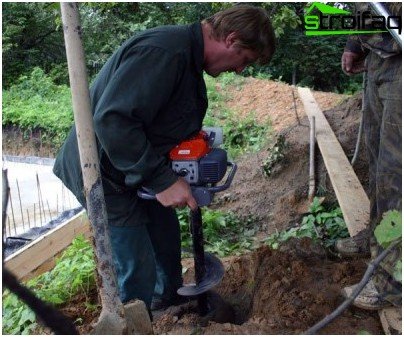
Reconnaissance drilling on the site can be done manually, or you can
- barometric method – allows you to accurately determine the depth of groundwater. For this, it is necessary to make simple measurements of atmospheric pressure with an aneroid barometer. The first measurement at a nearby reservoir. The second measurement – at the site of the proposed well. And then subtract the second value from the first. For example, the pressure indicator for the rate was 560.7 mm. r / s. Measurement at the site of the future well showed 560, 1mm.r / s. 560.7 – 560.1 = 0.6. Each tenth is approximately 1 meter. That is, you need to be prepared for the fact that the depth of the proposed well will be at least 6 meters. Method effectiveness 80%.

Simple and reliable aneroid barometer
Important! The deeper the well, the less likely it will dry out. Optimum depth – from 8 meters.
How to determine a place for a well – 3 golden rules
So, we know how to find a place for a well using folk and geological methods. Now let’s answer the question of how to choose a place for the well, taking into account the characteristics of your site. You will find out about it right now.

An example of the correct choice of location for a well; not far from home, doesn’t bother anyone, is located on a high place
You must adhere to three golden rules.
Rule one
The well should not interfere:
- passage to the house and courtyards;
- prospective construction (if any);
- trees growing on the plot, etc..
Remember, a well is not a closet. You can’t just take it and rearrange it in another corner..
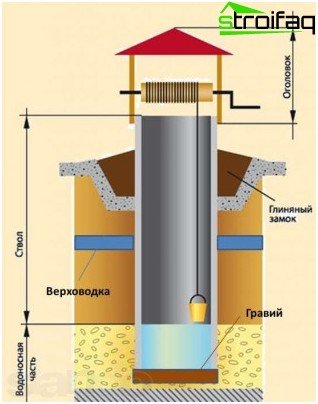
The correct well bookmarking scheme looks exactly like this
Second rule
Within the aquifer, select the highest place for the well. This is a guarantee that with a high degree of probability there will be no stagnant pits and quicksand below. For the well, this is certainly very important..
Rule three
Dig a well near your home. If you plan to get water out of it the old fashioned way – it will be easier to handle the buckets. If a pump is provided for raising water, you do not have to buy a heavy-duty unit. And in winter it’s easier to clear the path. But it’s also not worth digging a well very close to the house. There will be a chance of rainwater entering from under the foundation. The optimal distance is 8 meters from the wall and one and a half meters from the fence.
Note: check that the neighboring toilet of the “toilet” type is not higher than your well (according to the terrain). Although, experts say that wells are not affected by such contents, it is better for especially impressionable people to think about it right away.
Why does a well need a roof
You probably noticed that the old village wells had a roof. It was she who protected the well water:
- from excessive evaporation in summer;
- from leaf fall in the fall;
- from snow;
- from melt and rain admixtures in winter and spring.
And if everything is very clear with the first and second positions, then the rest deserves explanation. In no case should melt and rain water get into the well, its cumulative part! With them in the well water will be dangerous bacteria and harmful chemicals from the surface of the beds.
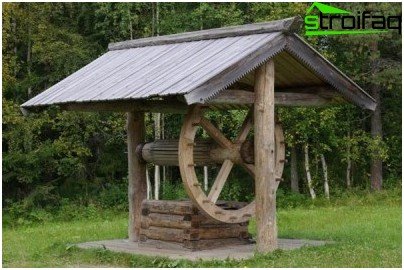
Here is a great example of a well with a solid wooden roof

The roof plus sunroof is a double guarantee that unwanted rain and debris will not get into the well. In dry weather, it is advisable to keep the hatch open – the well should breathe
How to find out that uninvited water from the surface got into the well?
- Well rings (which are higher than the water level in the well) get wet after prolonged prolonged rains. Moreover, you can see how water is dripping between the rings.
- If usually there is little water in the well or it is at an average level. And suddenly – it rises sharply and becomes muddy.
- Water starts to smell bad when heated. This is perhaps the most alarming signal. This is due to the formation of mucus, which is nothing but colonies of microorganisms that have fallen from the surface of the soil..
In these cases, it is necessary to pump out all the water from the well and replace it with a new one. It will also be useful to make a control analysis of water. And if everything is bad – disinfect.
Note: Of course, water cannot but get into the well from the ground. But in a well-constructed well, it goes a long way in filtering. Moreover, this “journey” from the surface to the reservoir takes more than one month. Accordingly, during this time the water is purified.
Water has disappeared in the well – what to do
Alas, this happens: suddenly you are left without water. If water has left the well, there are several reasons for this:
- change in the hydrogeological characteristics of the terrain on which the well is located;
- depletion of a water lens or water carrier, from where the well is fed;
- Reclamation work in the district;
- abstraction of a large amount of water from a water carrier in a well;
- cycles of water vibrations, etc..
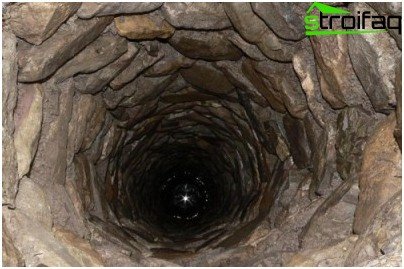
The water level in the well is directly dependent on weather conditions. In the hot summer, a slight decrease in the level is quite normal.
Alternatively, a similar problem can be solved in the following way: to deepen the well with a wooden log house or rings of a smaller diameter than the already standing ones.
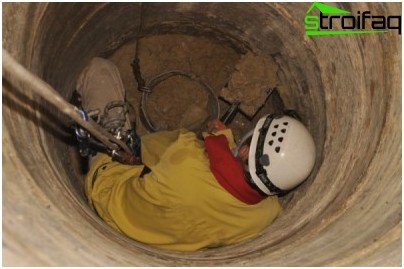
Deepening wells – a lesson for professionals
But, such work is not an easy task. And if you are not a specialist, it is better to invite professional well people. So you spend money, but not health.
When to deepen a well
Deepening the old well is a laborious and expensive undertaking. The efficient owner decides on this procedure in the following cases:
- the depth of the well is more than ten rings – dig a new well, in any case, more expensive;
- the size of the site will not allow to dig another well;
- the old well was crushed, but it had tasty water;
- the inflow of water per day is less than one ring;
- the well column is not a curve, and large horizontal displacements are not observed between the rings.
It is important to consider one very serious point. The fact is that very often after the construction of a well, a barely noticeable thin film appears on the surface of the water, suspiciously resembling an oil one (which it actually is). This is due to the fact that in the manufacture of rings the molds for their casting are lubricated with machine oil, and it, of course, remains on the rings. You understand, this seasoning will not add any benefit to water. How to avoid a similar situation? Yes, just find rings whose shapes are smeared with wax. They are produced in our country and do absolutely no harm when in contact with water..
Well, perhaps that’s all for today. It’s time to take stock:
- to search for water, you can use both folk and geological methods;
- the right well is built at the highest possible place within the aquifer;
- it should not interfere with the passage and passage to the house;
- to protect from melt and rainwater, a roof or a protective canopy must be built above the well.

Go for it! And may the water in your well be always clean and tasty
We sincerely hope that this article has benefited you! And if you have any of your well secrets, share them in the comments!




